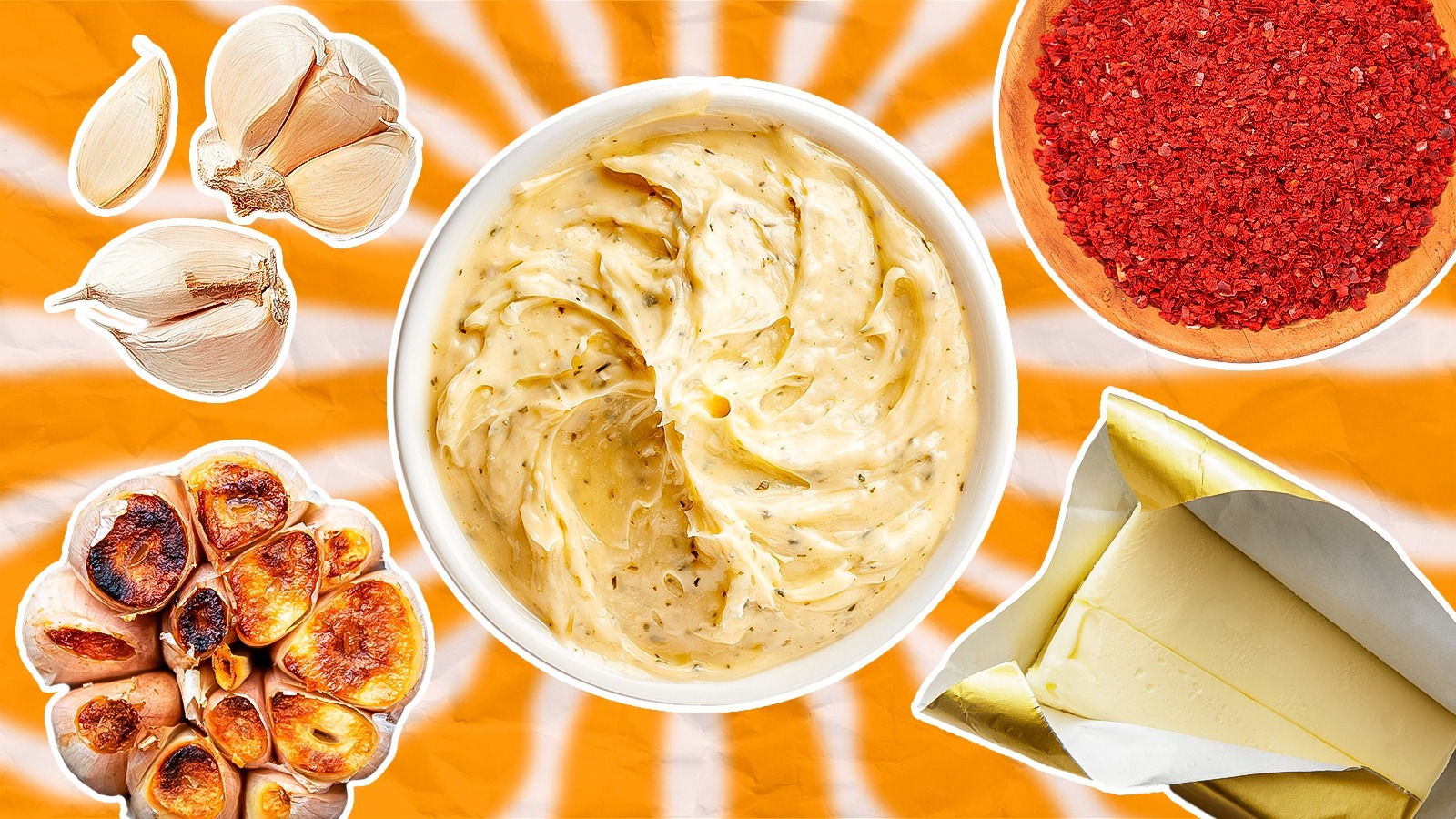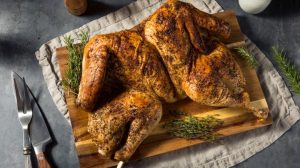Butter is an essential part of French cuisine, and it’s the French who were responsible for creating compound butter — known as beurre composé in their language. Compound butter is simply a mixture of butter with other ingredients to enhance its flavor. The combination of creamy butter and flavorful add-ins create a rich and delightful ingredient that can be used in cooking, or as a spread like plain butter but with an enhanced flavor.
Garlic is frequently used in global cuisine. While not everyone is a fan of this pungent allium, those who enjoy it can put it to delicious use by combining garlic with butter to make a type of compound butter known as — what else? — garlic butter. This enhanced butter is great for making garlic bread, creating flavored butter sauces, dipping seafood, cooking sautéed or roasted foods, spreading on toast or crostini, and simply topping steak, chicken, or vegetables. It’s very customizable, so you can play with your favorite ingredient combinations.
Garlic butter is such a delicious and seemingly complex ingredient that it may surprise you how easy it is to make at home, taking as little as five minutes. Try it and save a bundle on fancy compound butters sold at the store. These tips will help you make a flavorful, creamy spread that you’ll reach for time and time again to boost your meals with the richly intense flavor and texture that garlic butter provides so well.
Use the right kind of butter
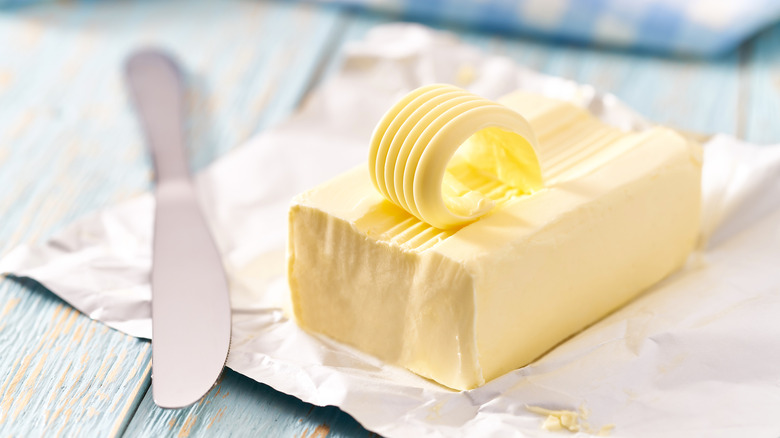
Garlic butter, as the name suggests, has two principal ingredients. Since butter is one of the stars of the show, try to use a good-quality product. We’re not saying you need to splurge on one of the best fancy butter brands, unless you want to. Luxurious butter is on the market from countries like Italy, Scandinavia, Ireland, the United States (especially from Vermont), and of course, France, a country that places high importance on their butter quality. Rodolphe Le Meunier butter — which is handcrafted in France’s Loire Valley, and is considered as a delicacy on this side of the pond — would certainly be a delicious choice. But let’s face it: even your average supermarket brand is still pretty delicious. Because … butter.
That said, choose a butter that fits your tastes and budget. American butter has an 80% butterfat content, while European and Irish butters are creamier, with 82% butterfat. Amish butters have even more at 84%. Some prefer butter from grass-fed cows, and you can make garlic butter with plant-based butter for a dairy-free alternative. Light butter isn’t great for baking, but it works well as a spread, so it’s a good choice for cutting back on fat. Any of these will make a delicious garlic butter. There is some disagreement over whether salted or unsalted butter is best. Unsalted butter gives you a blank canvas to work from, but you’ll need to add salt to round out the flavor.
Make sure your garlic is fresh
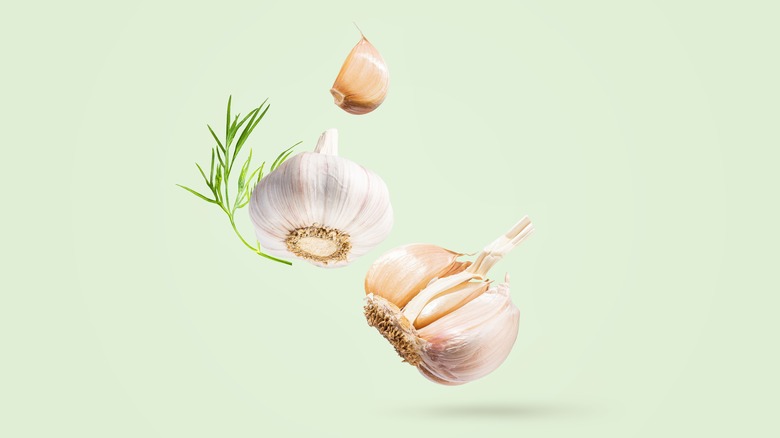
Garlic is the other main ingredient of this irresistible spread, so you’ll want to make sure the garlic you use is at its best. Garlic can be stored for a long time, but it will eventually go bad, changing its flavor. So, here’s what to look for when buying garlic at the grocery store. Fresh garlic will be firm, so give it a little squeeze to check it. Any soft spots indicate rotting underneath. Give the bulb a good sniff too — while garlic is notoriously pungent, you shouldn’t be able to smell much before you peel it. A strong odor means the bulb has already turned. Avoid sprouting garlic, because green shoots mean the heads are older and have been sitting around for awhile.
If you’re buying garlic for the pantry, keep in mind the best ways to keep garlic fresh so it will be ready when you are. Store whole cloves at room temperature, away from humidity and direct light. A covered bowl, paper bag, or a dedicated garlic keeper will work well.
Garlic cloves enliven recipes with a fresh and strong flavor, but if you can’t access fresh garlic, garlic powder can be an alternative choice for your garlic butter recipe. In fact, some recipes call for it. For every garlic clove your recipe calls for, substitute a quarter teaspoon of garlic powder.
Roast the garlic
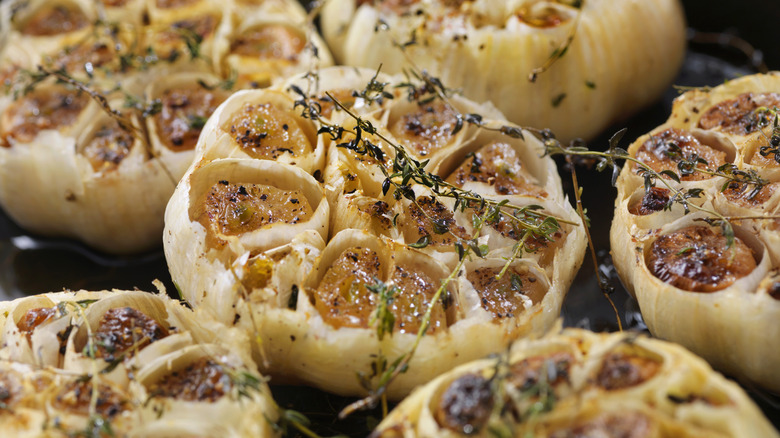
Garlic lovers agree that this pungent allium has a show-stopping flavor on its own, whether it’s minced and added raw to recipes, sautéed in olive oil, or baked into dishes. But there’s a simple way to enhance the flavor of garlic with a different technique. Roasting garlic takes away its strong punch of flavor, transforming it into a milder version of itself that’s simply delicious. Roasting the heads at high temperatures caramelizes the garlic, which gives it a slightly sweet taste and a richer, more complex flavor. Roasted garlic is irresistible by itself on bread, but adding it to your garlic butter will give your homemade spread an added mellowness and a greater depth of flavor at the same time.
There are several ways to roast garlic before adding it to your compound butter recipe. A common method of doing this is to wrap the garlic heads in foil (slice the pointy tops off first) and roast them directly on the oven rack for at least 30 minutes. If you prefer not to use foil, you can place them in muffin tins instead. Other devices beside the oven are an option. You can successfully roast garlic in an air fryer, although it’ll be a little crispier. A slow cooker works well to create soft, spreadable cloves, if you don’t mind waiting a few hours. Blend the roasted, peeled cloves in a food processor with butter and salt to create a delectable roasted-garlic butter spread.
Prep your ingredients well
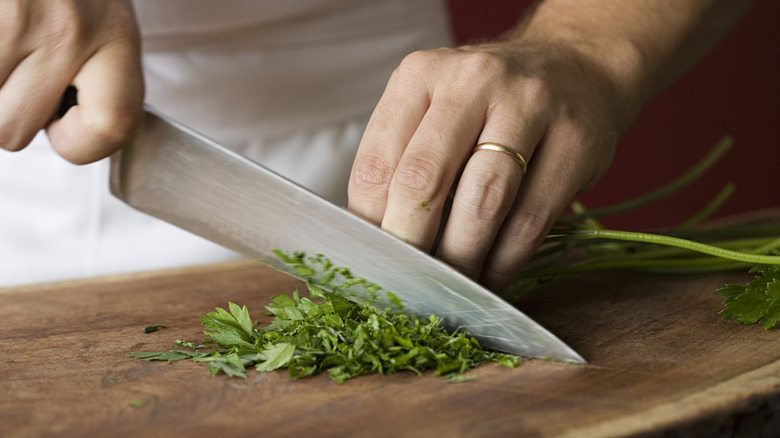
Image Source/Getty Images
Garlic butter is relatively easy to make, but even the simplest recipes require high-quality ingredients and good techniques for the best results. There are a few things you can do to make sure your garlic butter turns out well. First, make sure you use softened butter. Leave the butter out at room temperature for 30-60 minutes before you start making your recipe. Cold, hard butter will be much more difficult to mix with the other ingredients.
Be sure to mince or finely mince the garlic. While mincing is defined as cutting an ingredient into small pieces that are less than ⅛ of an inch long, a fine mince can be even smaller. Small and even pieces will distribute the garlic flavor throughout the butter, making the flavor smoother, and eliminating the risk of biting into a large, very strong piece of fresh garlic. You can mince garlic with a sharp chef’s knife or mezzaluna knife, or you can opt to crush it with a garlic press. It’s also possible to use the back of a fork to mince garlic extra-fine without a garlic press.
When using fresh seasonings or herbs, make sure to dry them well before adding them to the butter. The same goes for ingredients packed in liquids, like capers or sun-dried tomatoes packed in oil, or chipotle peppers canned in adobo sauce. Any excess moisture will water down the final result.
Seasonings are your friend
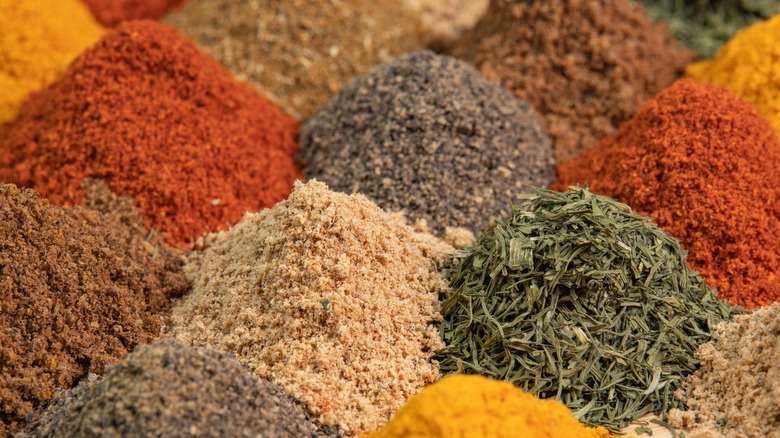
There’s a lot to love about a simple, understated recipe, and plain garlic butter is pretty delicious on its own. However, sometimes we’re in the mood to pull out all the stops and enhance the classic version with extra flavors. The good news is that garlic butter is really customizable. Since garlic and butter are standard savory ingredients used in a wide range of recipes across different culinary traditions, chances are some of your favorite flavor combinations will work in a garlic butter recipe.
If you’re a fan of Italian food, add Parmesan cheese and dried parsley to your recipe, try a sprinkling of Italian seasoning, or add lemon, capers, or sun-dried tomatoes. Regular salt can be replaced with garlic salt, and you can experiment with different colored peppercorns — white pepper is a popular choice. Add your favorite fresh herbs like basil, rosemary, chives, or mint, or use dry spices like paprika or dill. You can make a spicy Southern garlic butter with Cajun seasoning. You can even season with vegetables like celery for a special flavor, or add Worcestershire sauce for a steak’s garlic butter topping.
No matter what you use, first prep the seasonings properly. Zest lemons, grate cheese, and mince or very finely chop plant ingredients into very small, even pieces. This way their flavors will be evenly distributed and the texture won’t be lumpy.
Mix it properly
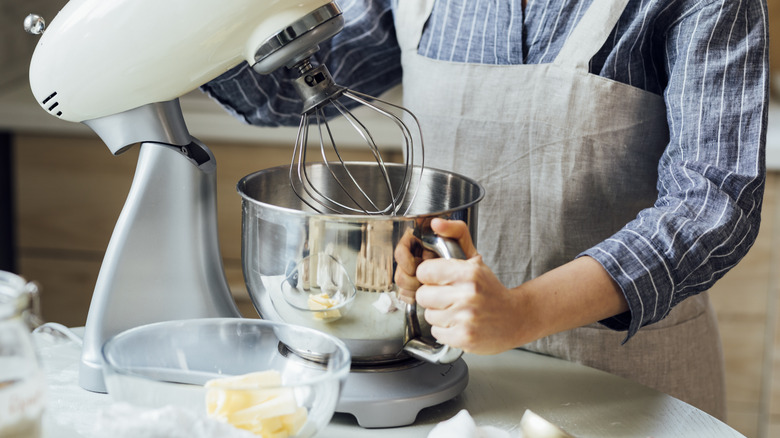
There are many helpful tips for making compound butter so that the final result is the right combination of creamy and light. One of the most important steps is to soften the butter beforehand. The butter should be soft enough to be easily and evenly mixed with the other ingredients, but not so soft that it melts or separates. Try pressing the butter with your finger — it should be soft enough to make a dent, but not go all the way through.
You have a few options for mixing garlic butter. You can blend it by hand with a fork. This is the simplest way and it yields good results. You can also mix it with a food processor, which is faster. If you like the texture of whipped butter, you can make incredibly light and airy whipped garlic butter at home using a hand mixer or stand mixer. Set the machine on medium and whip the butter alone for about two minutes until it’s nice and fluffy. Then place your add-ins in the bowl and mix again until they’ve just combined. If you don’t have a mixer, you can whip the butter by hand with a whisk. It will take more muscle, and you may not get it as fluffy, but you can achieve similar results with patience. Use circular motions to incorporate as much air as you can with each revolution of the whisk.
Keep it simple
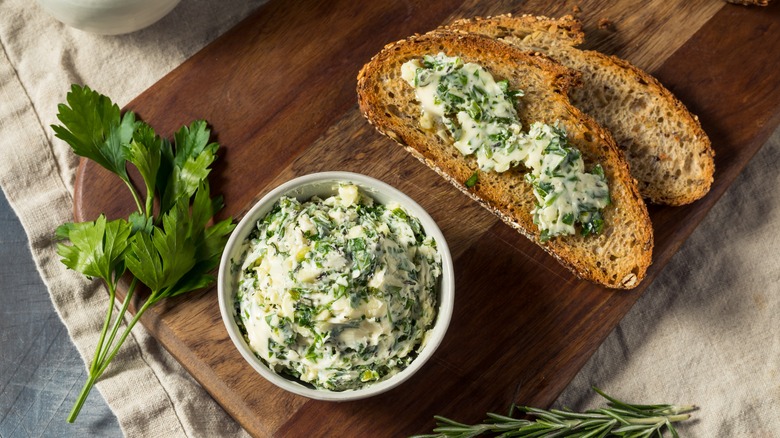
A basic garlic butter really only requires two ingredients: garlic and salted butter. If you’re using unsalted butter, then the ingredient list grows to three, because you’ll need to add salt. Simplicity is a great way to savor incredible flavors on their own. For the best results, choose good-quality ingredients, because you will taste each one. Fresh herbs are a simple way to add fresh and concentrated flavor to foods, and they work very well in garlic butter. Any fresh herb that you would normally cook with, or combine with garlic or butter in your normal cooking, will be a good choice here.
A simple three-ingredient garlic butter recipe requires only salted butter, garlic, and fresh parsley. The preparation is simple too, as the spread comes together in just five minutes. You’ll need softened butter or it won’t mix well, so let the butter sit out for up to an hour before you use it. Finely chop the herbs and crush the garlic in a garlic press before you start. You can also mince the garlic with a chef’s knife if you prefer. The important part is to cut it small so that the flavor can spread evenly throughout the butter. All that’s left after that is to mix the three ingredients together with a hand mixer until it’s light and fluffy.
Make it spicy
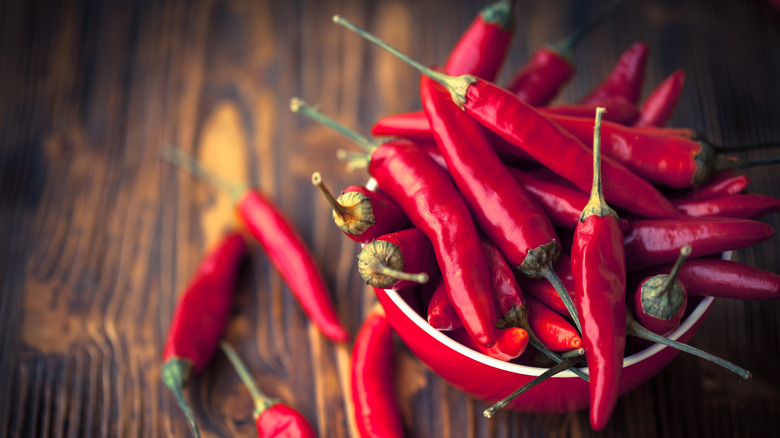
Spice lovers can add an extra element of heat to garlic butter recipes to make this delicious spread even more enjoyable. A simple way to add heat is with chili pepper. There are many varieties of chili peppers with different colors and heat levels, and there’s really no right or wrong here. Use available peppers, mince them small, and mix them in well with your other garlic butter ingredients. You can also opt to use dried chili powder instead. Red pepper flakes can be used, but if a smooth texture is important to you, then stick to the powder. Adding hot sauce or chili oil instead of fresh or dried chili peppers is another technique to add spice to garlic butter.
You can add Cajun seasoning to your compound butter recipe to make a flavorful and hot Cajun-style garlic butter. The spices in this seasoning can vary, but they often include paprika, cayenne, onion powder, oregano, thyme, salt, and pepper. If you like a little spice but want to keep the heat turned down, you can enhance your garlic butter with smoked paprika or ginger instead of chili pepper. Use fresh grated ginger or a little dried ginger powder.
For a Latin touch, try a spicy chipotle and roasted garlic compound butter recipe. You’ll blend together roasted garlic cloves, chipotle peppers in adobo sauce, butter, and salt in a food processor until well mixed.
Use shallots
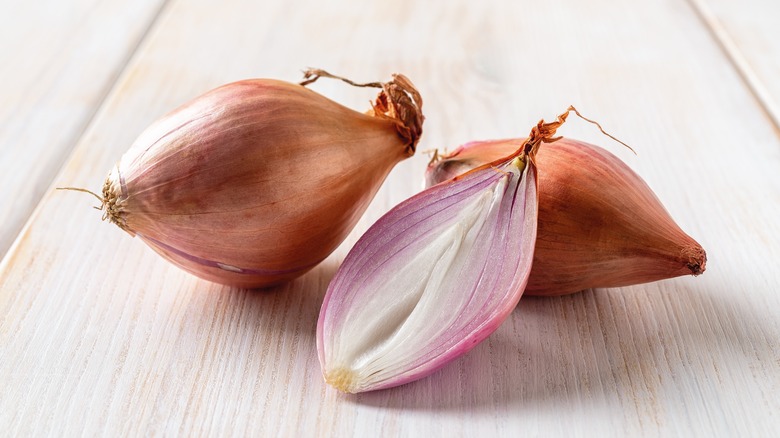
Shallots belong to the allium family along with garlic, onions, scallions, and leeks. They have a milder flavor than onions, making it easier to eat them raw. Some people describe their flavor as a mix between onion and garlic. When they’re cooked, shallots develop a sweeter and very pleasing flavor. One surprising way to use this versatile ingredient is in garlic butter. Technically, you could replace the garlic in roasted garlic butter with roasted shallot, and while we think this would be delicious, it wouldn’t really be garlic butter anymore. What you can do instead is add roasted shallots to garlic butter made with raw garlic for an extra level of flavor.
Shallots can be roasted just like garlic can. Some recipes call for cutting off the tops of the shallots like you would do with garlic to expose the cloves, while others omit this step and call for quartering them instead. You’ll get good results either way. Then, lightly drizzle the shallots with olive oil, seal them in foil, and roast them until they’re tender.
Adding roasted shallots to garlic butter will contribute a complex, sweet, and savory flavor to the sharp taste of raw garlic. Blended into a creamy mixture with butter, salt, and fresh herbs, it’s an irresistible match. Using roasted shallot garlic butter is a simple trick to level up your garlic bread. Either mix the soft roasted shallots into the garlic butter itself, or add them as a topping before toasting the bread.
Create truffle butter for a sophisticated touch

Truffles are a type of edible fungus that grows underground. They bear spores and look like old, dark, misshapen potatoes. Truffles have a strong, unique flavor appreciated by many as a delicacy. It’s hard to describe this flavor, but it can be liked to an intense, mushroomy, earthy, nutty, garlicky, and musty taste. Because the flavor is so strong, a little goes a long way. If you use too much, your dish may be inedible.
There are several ways to make truffle garlic butter and lend a luxurious touch to your spread. One of the best ways to use truffles doesn’t involve cutting or adding truffles at all. Truffles have a strong aroma that can infiltrate adjacent foods. The flavor compounds that create this aroma are fat soluble, which means that butter — which is mostly fat — will capture the aroma easily. The aroma will even penetrate the butter’s wrapping. Just place sticks of butter and truffles together in a plastic bag in the refrigerator and let it sit for a couple of days. Then, use the new truffle-infused butter to make garlic butter.
If you don’t have much time, or you prefer to use the truffles themselves, you can mince a small amount of black truffle and add it to your garlic butter recipe. Be conservative and taste as you go, keeping in mind the intensity of the flavor. If real truffles aren’t an option, you can use black truffle salt instead.
Store it properly
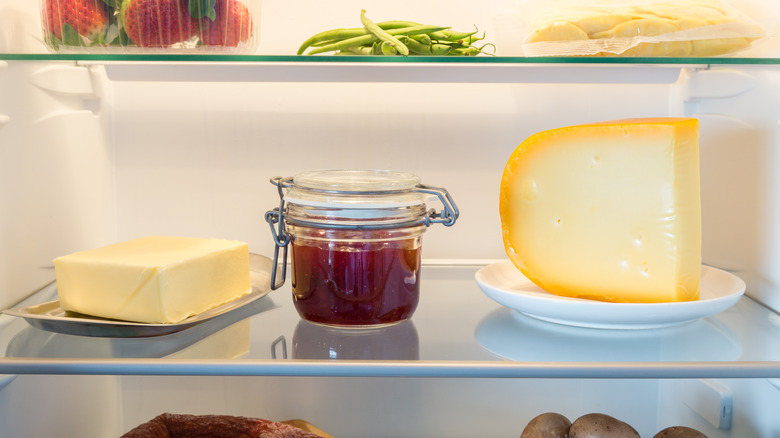
Garlic and butter are both perishable ingredients, so if you make garlic butter ahead of time or have leftovers, make sure to store it in the refrigerator. This will slow down bacterial or mold growth, and reduce the chance of food-borne illnesses like botulism. Keep the garlic butter in an airtight container. Reducing the amount of air that comes in contact with the spread will keep it fresh for longer. It will also preserve the flavor and keep the aroma from infiltrating other items in the refrigerator.
While some sources state that garlic butter will remain safe to eat for up to 15 days when stored this way, others caution to consume it within four to five days. To be on the safe side, use it as quickly as possible, or make small batches with just the quantity you will consume in a few days. If preparing a small batch is inconvenient, you can freeze leftover garlic butter for up to six months. Freeze it in small batches in separate containers to make it easy to only thaw the amount that you will need each time, rather than repeatedly thawing and refreezing a larger batch. An easy way to do this is to spoon small amounts into the compartments of an ice cube tray. To defrost a portion, leave it out on the counter for one hour.



